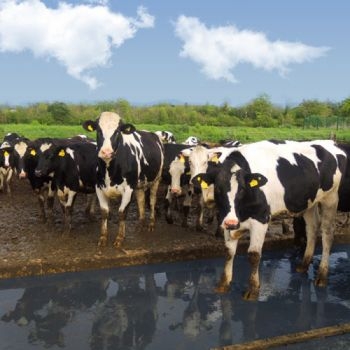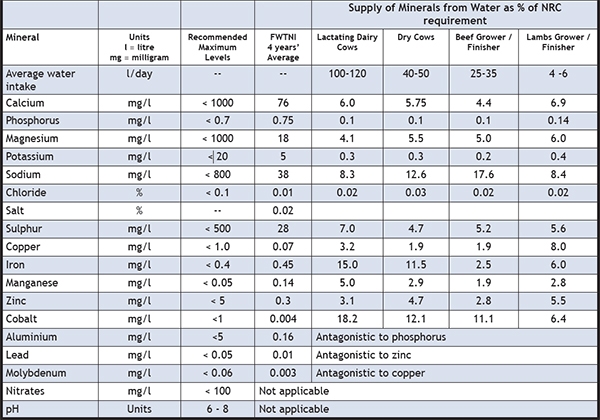
Understanding Water Mineral Analysis Report
Water intake and quality plays a very important role in the health and productivity of livestock.
50-80% of the body is comprised of water. Milk is roughly 87% water. Mineral content is a part of water quality. These minerals contribute to the total daily intake of livestock and as such any responsible approach to the determination of the mineral balance of the complete diet should consider that supplied from water.
The mineral content of water will vary due to a number of factors including, for example, bore hole, mains, area source and contamination.
Indeed, the increasing use of bore hole water, which will inevitably contain more ‘contaminants’ than mains water, has further focussed the need to check the water quality supplied to livestock.
The Frank Wright laboratory undertakes the analysis of water for major and trace minerals and some antagonistic minerals.
The major minerals analysed are calcium, phosphorus, magnesium, potassium, sodium, chloride, salt and sulphur. For trace minerals copper, iron, manganese, zinc and cobalt are analysed, and for antagonists, aluminium, lead and molybdenum.
The results are reported in a colour chart format, with the range of the figures centred on the average content of the element as found in water over the past 4 years of Frank Wright laboratory analyses.
In addition, pH is measured to monitor the acidity of the water. pH 7 is neutral, below 7 it is acidic and above 7 it is alkaline. pH lower than 5.5 can lead to acidosis and reduced feed intake. Excessively alkaline pH can upset the digestive system. Extreme pH can also shift acid-base balance in cattle whilst in some literature it is shown that pH affects the solubility and hence bioavailability of the minerals.
Nitrate content is also monitored as excessive intakes can lead to poisoning. Although nitrate itself is not very harmful it can be reduced by rumen microbes
to nitrite, which is more potent and at high levels can lead to restlessness, difficult breathing (due to the lock-up of oxygen transporting red blood cells) and decreased feed and water intake. As a general guidance intake of nitrates of < 50,000mg/head/day is considered as safe.
The recommended nitrate level in water is < 100mg/l which, with a water intake of 100 litres can provide up to 10,000 mg per day. Where the amount in water exceeds 100mg/l then the nitrate content of forages (especially grass silage and fresh grass) should be considered in order to check that the total daily intake does not exceed the critical maximum of 50,000mg/head/day.
Bioavailabilities of minerals in water
It is generally assumed that because the minerals in water are dissolved they are 100% biologically available to livestock. However, this is not clear as the literature regarding mineral bioavailability in water is scarce.
To make the matters worse there are other factors which can affect the bioavailability, including solubility and chemical composition of that particular mineral. Iron for example, an essential trace element which at high levels can also be antagonistic to the absorption of copper, is in a less soluble ferric form at pH 7 than at pH 9 and therefore may be less bioavailable at the lower pH.
The mineral contribution from water is often ignored when it comes to ration formulation. Indeed, even if it is considered that the minerals in the water are 100% available, it generally contributes only a small proportion of the animals mineral requirements. In the attached table the Frank Wright average values from samples analysed in the laboratory in the past 4 years are listed. From these, based on average water intake, the mineral supply compared to ‘basic’ National Research Council requirement is given as a % for lactating cows, dry cows, beef and sheep. For example, lactating cows producing 35 litres per day can drink in excess of 100 litres of water per day which, based on the 4 year average, can provide between 0.1 and 18% of ‘basic’ mineral requirements per head per day. Of course, if production changes then water intake and mineral requirements also change. This also holds true for different species.
In addition, the antagonists aluminium, lead and molybdenum are detailed in the table, not to forget the negative effects of excess potassium (on magnesium), sulphur and iron (on copper in association with molybdenum). Exact quantification of the impact of these antagonists is difficult due to the question of bioavailability and, most importantly, the impact of the mineral balance of the remainder of the ration.
The table also details the ‘Recommended maximum mineral levels’ in water as documented in Mineral levels in Animal Health - Diagnostic data by Robert Puls. The main reasons for these maximum limits are that they affect the palatability although sometimes there are other reasons e.g. in-appetence and potential damage to various body organs. To add to the uncertainty, there are some very different values given in the currently available literature.
Summary
Responsible mineral nutrition requires the farm adviser to balance rations based on all sources of minerals. One source can be water and with increasing use of bore hole supplies it is sensible to consider this in the overall mineral balance of the total diet.





